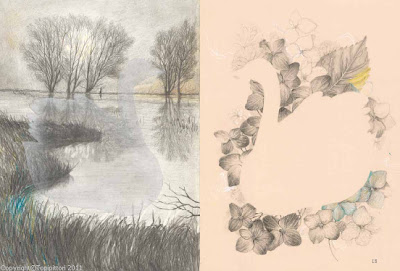Wild Swans by Hans Christian Andersen, illustrated by Joanna Concejo, translation by Maria Jacob, Ed Topipittori, February 2011
Every time I open a picture book by Joanna Concejo me shake my wrists with emotion, as his images I get to the heart, without filters or inhibitions. is stronger than me, engulfs the entire emotional wave that will not let me breath, as if all the most beautiful and sad memories come out from their drawers ordered and began to dance up and down my body.
When I heard that John and Paul, the mice to be clear, the texts were assigned to one of the most beautiful and inaccessible of Andersen I deeply enjoyed, certainly not for sadism: this was one of the stories my grandmother told me more often and I could not wait to be able to dive in the interpretation that would have given Joanna.
is not easy to deal with a classic, much less if the classic Hans Christian Andersen is signed, because the psychological complexity of his stories is heavy, so make its melancholic and poetic is extremely difficult because the hardness of his stories seems to be hopeless at times (I still feel the anguish that, babe, I tried to read The Little Mermaid). It is not easy to give as a mind so fine and restless.
This account, in particular, is extremely complex because it represents the fall from paradise into the abyss of childhood that often accompany adolescence, between disillusionment and an inability to communicate, including the loss of affections loved ones and the desperate attempt to bring them back to itself.
The protagonist, Elisa, is alone. Left to itself, every minute of his life is linked in memory of his beloved brothers, now finds himself an adult, and the moments spent together. As in all fairy tales are observed, an advocate of the fall is the wicked stepmother who alienates children from their father and condemns them to a silence imposed by the metamorphosis into swans for the brothers and forced the dismissal for Elisa.
Elisa is a child first and then a young woman of great virtue, as is well-suited to the classic fairy-tale heroine: beautiful, gentle, unwavering religious faith, she entrusts his fate and that of brothers Swans-God's mercy, strictly following the precepts given to it without doubt, without any failure. In spite of physical suffering caused by the nettle that is forced to spin to make shirts that dissolve the spell of the witch-stepmother, in spite of the risks she was running, the young woman will complete its task in ensuring herself and longed for a happy ending to his brothers.
Joanna has made an interpretation of this wonderful tale, full of symbolic references and senior moments. His illustrations stress in many ways the loneliness of Elisa, as in the illustration below, in which the nettles form a kind of frame / prison island in the beautiful princess from the rest of the world:
Caught from behind, bent over their work, the young woman looks like a bent twig to the mutability of life is not addressed to us than we observe, not uttering a word, otherwise his beloved brothers die.
But I would draw your attention to the first image of this post, the board speculate that depicts the silhouette of a swan, as this illustration powerfully evokes the idea of \u200b\u200bpresence / absence of brothers: the left side of the sheet Swan has a ghost, only vaguely hinted at, and distant figure, the size of a Bruscolino, Elisa is the little wandering aimlessly in search of those who feel unable to see, on the right side of the swan that remains is the negative of the silhouette, as if to underline the distance, inaccessibility, lack.
The absence, together with the despair of not being able to continue in the task of weaving the eleven shirts, is echoed in this image
where, for a more descriptive we see tiny horsemen galloping towards the castle The King decides to take with you and Elisa to marry her, strongly opposes the image of the young woman, visibly desperate, whose image is at times eclipsed by these disks embroidered, transparent, also appear in the endpapers of the book. The presence of these objects seems to underline the feeling of emptiness that is created when the girl is separated from the brothers, leaving her body mutilated , erased, while the disc shape and the disposition to flock that will be the illustrator draws the idea of \u200b\u200btraveling and temporary nature of the situation.
last illustration that I propose, once again Elisa us back, once again there seems to be solitary heroine framed by fury and disbelief among the crowd that besieged the
Unique benign guardians the birds , who observed the scene from afar, as a symbol of the watchful eye of the sky.
Note finally the wonderful harmony of pastel plates of Joanna, the balance in the use of color, the delicacy of the stroke.
beautiful translation of Mary Jacob.
This book does not cost " half of the kingdom," it does not cost anywhere near what the precious book, Elisa, so if I have intrigued enough, I suggest you pass the library.
The book was published simultaneously in French, Editions Notari.
Copyright © text and images, Ed Topipittori 2011. The images have been published with the consent of the editor, each reproduction is strictly prohibited.







0 comments:
Post a Comment